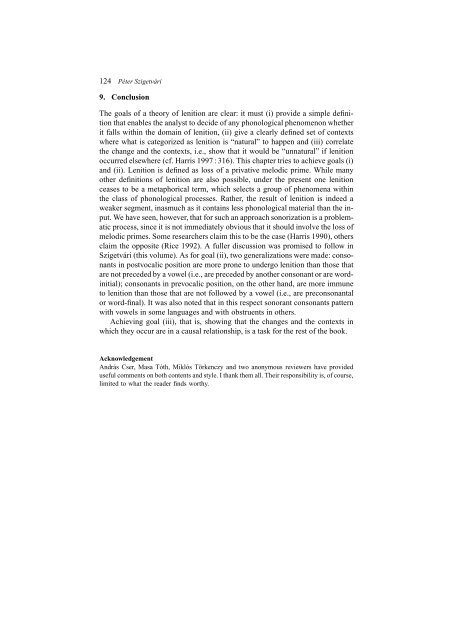What and where? Péter Szigetvári - SEAS
What and where? Péter Szigetvári - SEAS
What and where? Péter Szigetvári - SEAS
Create successful ePaper yourself
Turn your PDF publications into a flip-book with our unique Google optimized e-Paper software.
124 <strong>Péter</strong> <strong>Szigetvári</strong><br />
9. Conclusion<br />
The goals of a theory of lenition are clear: it must (i) provide a simple definition<br />
that enables the analyst to decide of any phonological phenomenon whether<br />
it falls within the domain of lenition, (ii) give a clearly defined set of contexts<br />
<strong>where</strong> what is categorized as lenition is “natural” to happen <strong>and</strong> (iii) correlate<br />
the change <strong>and</strong> the contexts, i.e., show that it would be “unnatural” if lenition<br />
occurred else<strong>where</strong> (cf. Harris 1997 : 316). This chapter tries to achieve goals (i)<br />
<strong>and</strong> (ii). Lenition is defined as loss of a privative melodic prime. While many<br />
other definitions of lenition are also possible, under the present one lenition<br />
ceases to be a metaphorical term, which selects a group of phenomena within<br />
the class of phonological processes. Rather, the result of lenition is indeed a<br />
weaker segment, inasmuch as it contains less phonological material than the input.<br />
We have seen, however, that for such an approach sonorization is a problematic<br />
process, since it is not immediately obvious that it should involve the loss of<br />
melodic primes. Some researchers claim this to be the case (Harris 1990), others<br />
claim the opposite (Rice 1992). A fuller discussion was promised to follow in<br />
<strong>Szigetvári</strong> (this volume). As for goal (ii), two generalizations were made: consonants<br />
in postvocalic position are more prone to undergo lenition than those that<br />
are not preceded by a vowel (i.e., are preceded by another consonant or are wordinitial);<br />
consonants in prevocalic position, on the other h<strong>and</strong>, are more immune<br />
to lenition than those that are not followed by a vowel (i.e., are preconsonantal<br />
or word-final). It was also noted that in this respect sonorant consonants pattern<br />
with vowels in some languages <strong>and</strong> with obstruents in others.<br />
Achieving goal (iii), that is, showing that the changes <strong>and</strong> the contexts in<br />
which they occur are in a causal relationship, is a task for the rest of the book.<br />
Acknowledgement<br />
András Cser, Masa Tóth, Miklós Törkenczy <strong>and</strong> two anonymous reviewers have provided<br />
useful comments on both contents <strong>and</strong> style. I thank them all. Their responsibility is, of course,<br />
limited to what the reader finds worthy.
















